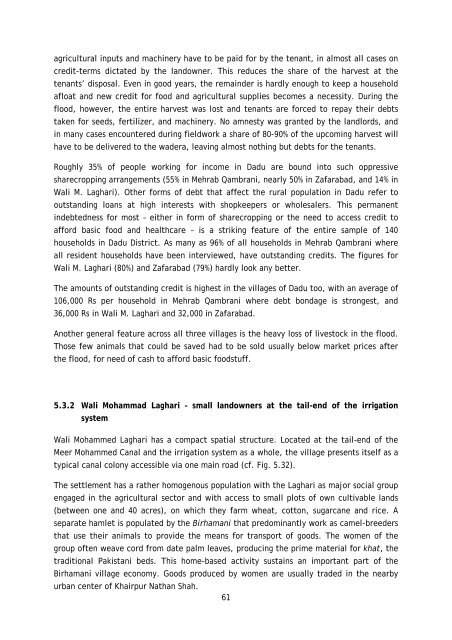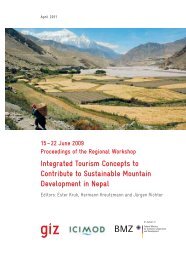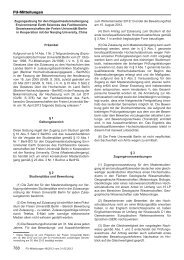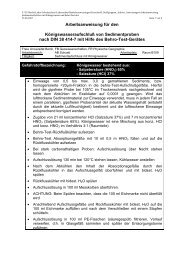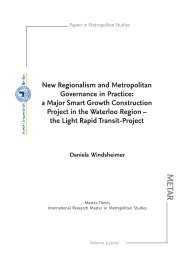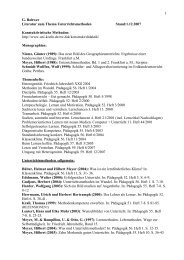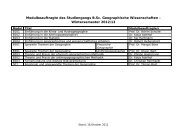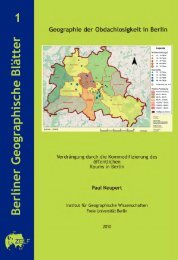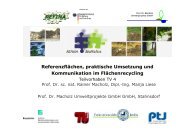After the Flood in Pakistan 38 Berlin Geographical Papers - Freie ...
After the Flood in Pakistan 38 Berlin Geographical Papers - Freie ...
After the Flood in Pakistan 38 Berlin Geographical Papers - Freie ...
You also want an ePaper? Increase the reach of your titles
YUMPU automatically turns print PDFs into web optimized ePapers that Google loves.
agricultural <strong>in</strong>puts and mach<strong>in</strong>ery have to be paid for by <strong>the</strong> tenant, <strong>in</strong> almost all cases on<br />
credit-terms dictated by <strong>the</strong> landowner. This reduces <strong>the</strong> share of <strong>the</strong> harvest at <strong>the</strong><br />
tenants’ disposal. Even <strong>in</strong> good years, <strong>the</strong> rema<strong>in</strong>der is hardly enough to keep a household<br />
afloat and new credit for food and agricultural supplies becomes a necessity. Dur<strong>in</strong>g <strong>the</strong><br />
flood, however, <strong>the</strong> entire harvest was lost and tenants are forced to repay <strong>the</strong>ir debts<br />
taken for seeds, fertilizer, and mach<strong>in</strong>ery. No amnesty was granted by <strong>the</strong> landlords, and<br />
<strong>in</strong> many cases encountered dur<strong>in</strong>g fieldwork a share of 80-90% of <strong>the</strong> upcom<strong>in</strong>g harvest will<br />
have to be delivered to <strong>the</strong> wadera, leav<strong>in</strong>g almost noth<strong>in</strong>g but debts for <strong>the</strong> tenants.<br />
Roughly 35% of people work<strong>in</strong>g for <strong>in</strong>come <strong>in</strong> Dadu are bound <strong>in</strong>to such oppressive<br />
sharecropp<strong>in</strong>g arrangements (55% <strong>in</strong> Mehrab Qambrani, nearly 50% <strong>in</strong> Zafarabad, and 14% <strong>in</strong><br />
Wali M. Laghari). O<strong>the</strong>r forms of debt that affect <strong>the</strong> rural population <strong>in</strong> Dadu refer to<br />
outstand<strong>in</strong>g loans at high <strong>in</strong>terests with shopkeepers or wholesalers. This permanent<br />
<strong>in</strong>debtedness for most – ei<strong>the</strong>r <strong>in</strong> form of sharecropp<strong>in</strong>g or <strong>the</strong> need to access credit to<br />
afford basic food and healthcare – is a strik<strong>in</strong>g feature of <strong>the</strong> entire sample of 140<br />
households <strong>in</strong> Dadu District. As many as 96% of all households <strong>in</strong> Mehrab Qambrani where<br />
all resident households have been <strong>in</strong>terviewed, have outstand<strong>in</strong>g credits. The figures for<br />
Wali M. Laghari (80%) and Zafarabad (79%) hardly look any better.<br />
The amounts of outstand<strong>in</strong>g credit is highest <strong>in</strong> <strong>the</strong> villages of Dadu too, with an average of<br />
106,000 Rs per household <strong>in</strong> Mehrab Qambrani where debt bondage is strongest, and<br />
36,000 Rs <strong>in</strong> Wali M. Laghari and 32,000 <strong>in</strong> Zafarabad.<br />
Ano<strong>the</strong>r general feature across all three villages is <strong>the</strong> heavy loss of livestock <strong>in</strong> <strong>the</strong> flood.<br />
Those few animals that could be saved had to be sold usually below market prices after<br />
<strong>the</strong> flood, for need of cash to afford basic foodstuff.<br />
5.3.2 Wali Mohammad Laghari – small landowners at <strong>the</strong> tail-end of <strong>the</strong> irrigation<br />
system<br />
Wali Mohammed Laghari has a compact spatial structure. Located at <strong>the</strong> tail-end of <strong>the</strong><br />
Meer Mohammed Canal and <strong>the</strong> irrigation system as a whole, <strong>the</strong> village presents itself as a<br />
typical canal colony accessible via one ma<strong>in</strong> road (cf. Fig. 5.32).<br />
The settlement has a ra<strong>the</strong>r homogenous population with <strong>the</strong> Laghari as major social group<br />
engaged <strong>in</strong> <strong>the</strong> agricultural sector and with access to small plots of own cultivable lands<br />
(between one and 40 acres), on which <strong>the</strong>y farm wheat, cotton, sugarcane and rice. A<br />
separate hamlet is populated by <strong>the</strong> Birhamani that predom<strong>in</strong>antly work as camel-breeders<br />
that use <strong>the</strong>ir animals to provide <strong>the</strong> means for transport of goods. The women of <strong>the</strong><br />
group often weave cord from date palm leaves, produc<strong>in</strong>g <strong>the</strong> prime material for khat, <strong>the</strong><br />
traditional <strong>Pakistan</strong>i beds. This home-based activity susta<strong>in</strong>s an important part of <strong>the</strong><br />
Birhamani village economy. Goods produced by women are usually traded <strong>in</strong> <strong>the</strong> nearby<br />
urban center of Khairpur Nathan Shah.<br />
61


